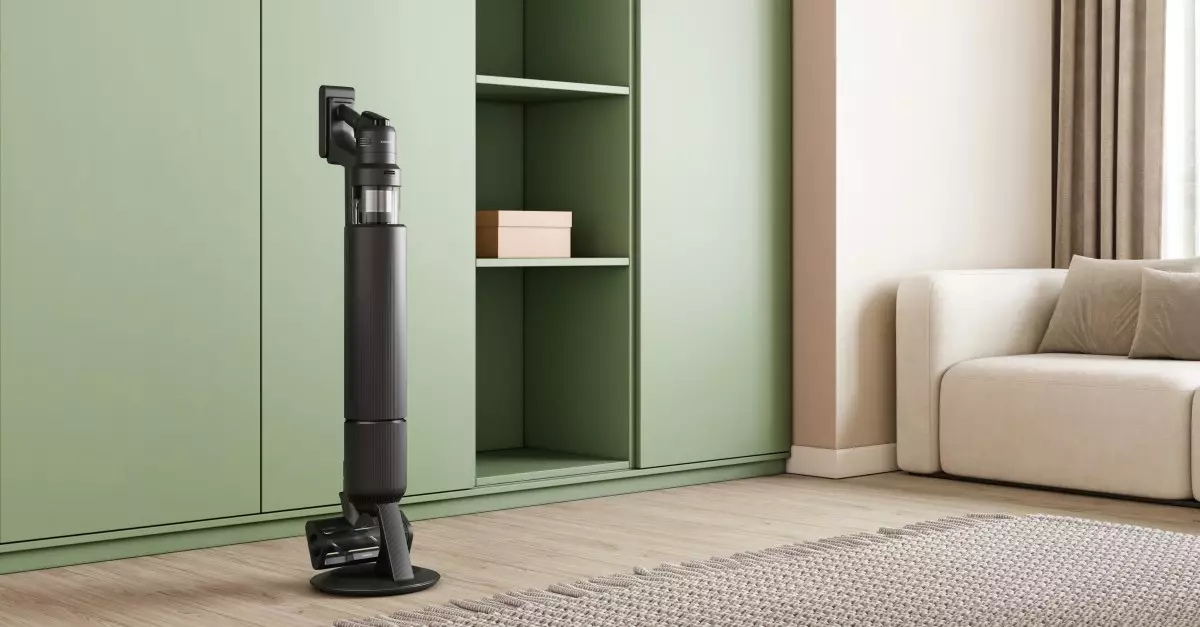The Bespoke Jet AI is heralding a new era in home appliance technology, pushing the boundaries of functionality and convenience in ways that were previously unimaginable. Now outfitted with an LCD display, this cordless stick vacuum not only embodies the essence of modern design but also transforms mundane tasks into connected experiences. Priced at a premium of $1,099, it features a control panel that serves as a dynamic interface for users. Displaying essential notifications such as incoming phone calls and text messages, it alleviates the constant worry of missing out on important communications while tackling household chores.
Imagine running a vacuum cleaner and seamlessly answering calls—all without disrupting your cleaning routine. This marriage of basic household equipment with smartphone integration is indicative of a larger trend towards smart homes, where every device serves dual functions. The vacuum features a remarkable 400AW suction power and a battery life that extends up to an hour and 40 minutes, proving that you won’t compromise on performance for connectivity. However, we have to ask ourselves: are these innovations really necessary, or is it a case of adding tech for the sake of adding tech?
Elevating Laundry with Smart Technology
In tandem with the Bespoke Jet AI, Samsung has unveiled significant advancements in laundry technology, introducing a vented combo washer/dryer priced at $3,099. This appliance boasts a 7-inch LCD touch display that enables direct phone communication, turning your laundry room into a mini command center. This not only allows you to handle calls without having to dash to your phone but also streamlines the washing process by automating detergent dispensing and door opening after a cycle.
The integration of facilitating technology into laundry makes it less of a chore and adds a sprinkle of intrigue to an otherwise monotonous task. With user-friendly interfaces that even handle the tedium associated with laundry, Samsung’s appliances promise an era of convenience. However, one can’t help but ponder: is this an advancement that genuinely enhances our daily lives, or is it another instance of unnecessary gadgetry wrapped in an appealing package?
The Overarching Trend of Smart Home Integration
At CES this year, Samsung showcased its broader vision of home automation, featuring AI-powered home appliances that create an ecosystem designed to tangentially connect various aspects of your living space. The AI Home control panels found in products like smart fridges and ovens are emblematic of a future where devices communicate seamlessly with each other. For instance, a smart fridge can suggest recipes based on its inventory, which can then be sent directly to the oven to aid in meal preparation. This suggests a future where hands-free convenience reigns supreme, but raises questions about the implications of relying too heavily on technology.
As these devices sync with platforms like Samsung’s SmartThings, users can also monitor their entire home environment. However, this level of integration could border on voyeurism within one’s own home. The constant notifications and potential interruptions presented by appliances doubling as communication devices may ultimately lead to a fragmented experience, overshadowing the intended convenience. Moreover, the relentless drive towards a fully connected smart home could lead to significant issues with privacy, data security, and the potential for incessant advertisement bombardment.
The Dichotomy of Convenience vs. Clutter
While the introduction of screens on household appliances offers an alluring promise of convenience, one cannot ignore the meticulous balance between enhancing functionality and overwhelming users with technological clutter. The overabundance of screens may appear as overkill—most of us own smartphones that serve as portable command centers. Wouldn’t a singular, well-placed smart display suffice to achieve similar goals without embedding multiple screens into every appliance?
Additionally, the durability of built-in technology remains a point of contention. Appliances with integrated touchscreens might face obsolescence or malfunctions quicker than traditional designs. The fear of finding oneself needing to replace expensive appliances due to a malfunctioning digital interface casts a shadow over the promised conveniences.
Furthermore, consumers ought to be cautious about the possibility of invasive advertising strategies infiltrating these home environments, reminiscent of the ads that appear on Amazon’s smart displays. While Samsung has yet to navigate this path, the potential is always looming, prompting customers to question whether the allure of smart connectivity is worth the risk of commercial infringement in their personal spaces.
The march of technology into every facet of our homes undoubtedly offers unparalleled convenience, but it’s paramount that we remain critical of the implications of this technological saturation in our lives. Balancing necessity with innovation will be the key to ensuring that we embrace progress without compromising our sanity in the process.

